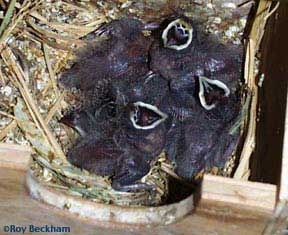




 |
|
|||||||||||||||||||||
 |
|
|
|
|
|
|
|
|
|
|||||||||||||
|
|
|
|
|
|
||||||||||||||||||
|
|
|
|
|
|
|
|
|
|
||||||||||||||
|
|
|
|
|
|
||||||||||||||||||
|
|
|
|
|
|
|
|
|
|
||||||||||||||
|
|
|
|
|
|
||||||||||||||||||
|
|
|
|
|
|
|
 |
|
|||||||||||||||
 |
 |
|
||||||||||||||||||||
|
|
|
|
||||||||||||||||||||
|
|
|
|
|
|
|
|
|
|
|
|
|
|
|
|
|
|
|
|
|
|
|
|
| Red Headed Finch - Amadina erythrocephala | |||||
 |
|||||
| Red Headed Finch (male) | |||||
|
Common Names Description Diet
Breeder's Notes Both the male and female share in the incubation duties of the rather large and roundish eggs. Clutches range from 4-8 eggs with 5 or 6 being pretty common. When you see the size of the egg in comparison with the size of the bird, you can see why calcium depletion is of concern with this species. The pair will begin incubation after the second to fourth egg is laid and lasts about 13-14 days. The young hatch out and look like they are all mouth. They are black and very fuzzy with large gaping mouths that are lined with yellow-white flanges (see below). They fledge after 3 weeks and require another 2-3 weeks until they are independent. The young males can be identified upon fledging by the red coloring on their head. Their body lacing is finer than the adults, but males still have different body patterns than hens. Some hens may fledge with some red on their heads, but usually not as much as males and can still be distinguished by the breast pattern. The Red Headed finch is not as aggressive in a mixed colony as its cousin the Cutthroat. While it is still a stout bird capable of defending itself, it is not as pugnacious and nasty and will leave other breeding finches alone. I had 3 pair breeding with a pair of Hawfinches, a colony of Spice finches and some Mountain quail in the same flight without incident. I have also had single pairs in small breeder cages go to nest, but they do better in larger flights. They can also be raised under Society finches. They have a very different begging behavior than the Society chicks, so it is best to start with eggs under a pair of Societies that have not raised any other kind of finch before. These first time parents have not "imprinted" on chicks and don't know what to expect from the hatchlings. Still, many Societies will not feed the young Red Headed finches due to their straight up begging pattern. It is also important that the eggs hatch under the Societies. It seems that just placing hatched young in the nest is disturbing to the Societies and they will not feed them. Additional Notes They should not housed with Cutthroats during the breeding season. The two species will cross and produce fertile hybrids. Hybrids are usually identified by the brightness of the red head. The males will have the red head of the Red Headed finch, but it will be the brighter red color of the Cutthroat finch. There are two subspecies, but I'm not certain as to the differences in color or size or if the subspecies even exists in aviculture. Red Headed finch males can learn to mimic other birds and even humans. A Red Headed finch male hand raised by Sally Huntington named Turkey has learned to say his name. (see Turkey) I have hand raised the Red Headed finch. The large gape does make for an easy target. See Hand Raising Finches. (Hand feeding a Red Headed finch hen) |

Clutch of five Red Headed chicks 12 days old. See the mouth markings of nestling Red Heads
